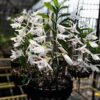# How to Revive Dendrobium Anosmum (Đai Châu) Orchids: A Comprehensive Guide to Treating Wilting Flowers

Dendrobium anosmum, commonly known as Đai Châu orchids, are cherished for their stunning, fragrant blooms and their ability to adapt to various growing conditions. However, like all plants, they can experience periods of stress and decline, often manifesting as wilting or drooping leaves and flowers. This guide provides an in-depth look at the potential causes of wilting in Đai Châu orchids, practical steps to revive them, and preventive measures to keep them healthy and thriving.
## Understanding Wilting in Dendrobium Anosmum Orchids
Before diving into solutions, it’s essential to understand what causes wilting in Dendrobium anosmum orchids. Wilting is a sign that the plant is under stress, often due to environmental factors, cultural practices, or health issues. Identifying the underlying cause is crucial for effective treatment.
### Common Causes of Wilting
1. **Watering Issues**
– **Underwatering**: When orchids don’t receive enough water, they can dehydrate, leading to wilting. Symptoms include shriveled leaves and dry, brittle roots.
– **Overwatering**: Conversely, excessive watering can cause root rot, preventing the plant from absorbing water and nutrients. Signs include yellowing leaves, mushy roots, and a foul smell from the potting medium.
2. **Humidity Levels**
– Dendrobium orchids thrive in humidity levels of 50% to 80%. Low humidity can cause the plant to lose moisture quickly, resulting in wilting.
3. **Temperature Stress**
– Extreme temperatures can shock orchids. High heat can lead to rapid moisture loss, while cold drafts can weaken the plant’s structure.
4. **Nutrient Deficiencies**
– A lack of essential nutrients can hinder the plant’s ability to sustain itself, leading to wilting. Symptoms may include discolored leaves and stunted growth.
5. **Pest Infestations**
– Pests like aphids, mealybugs, and spider mites can sap moisture and nutrients from the plant, causing it to weaken and wilt.
6. **Diseases**
– Fungal and bacterial infections can lead to wilting and other symptoms, including discoloration, lesions, or an unpleasant odor.
7. **Potting Medium Issues**
– An unsuitable or depleted potting mix can affect water retention and aeration, leading to wilting.
## Step-by-Step Guide to Reviving Wilting Dendrobium Anosmum Orchids
### Step 1: Assess the Situation
Before taking action, it’s important to assess your orchid’s condition. Check for signs of wilting, yellowing, or other abnormalities. Here are key areas to inspect:
– **Leaves**: Are they drooping or shriveled? Do they have discoloration?
– **Roots**: Carefully remove the orchid from its pot and inspect the roots. Healthy roots should be firm and green. Look for signs of rot (brown or mushy roots).
– **Potting Medium**: Is the potting medium dry, soggy, or compacted?
### Step 2: Address Watering Issues
Watering is often the first area to check when dealing with wilting orchids.
#### **Underwatering**
1. **Water the Plant**: If the potting medium feels dry, give your orchid a thorough watering. Ensure that excess water drains out of the pot’s holes.
2. **Soak Method**: For severely dehydrated orchids, consider the soak method. Submerge the pot in water for about 15–30 minutes to allow the medium to absorb moisture.
#### **Overwatering**
1. **Check for Root Rot**: If you notice mushy, brown roots, root rot may be present. Trim away any affected roots with sterilized scissors.
2. **Repotting**: If the potting medium is too wet, consider repotting the orchid into fresh, dry orchid mix. This helps ensure better drainage.
### Step 3: Adjust Humidity Levels
If low humidity is the issue, take steps to increase moisture in the air.
– **Misting**: Lightly mist the leaves and flowers daily to increase humidity.
– **Humidity Trays**: Place a shallow tray filled with water and pebbles beneath the pot. As the water evaporates, it will increase humidity around the orchid.
– **Humidifiers**: Consider using a humidifier in the room to maintain optimal humidity levels for your orchids.
### Step 4: Regulate Temperature
Maintaining a stable temperature is vital for the health of Dendrobium anosmum orchids.
– **Ideal Temperature**: These orchids prefer temperatures between 65°F (18°C) at night and 85°F (29°C) during the day. Avoid exposing them to cold drafts or placing them near heat sources.
– **Monitoring**: Use a thermometer to regularly check the temperature in the growing area.
### Step 5: Fertilization
If nutrient deficiency is suspected, provide your orchid with the necessary nutrients.
– **Fertilizer**: Use a balanced, water-soluble orchid fertilizer (e.g., 30-10-10) every two weeks during the growing season. Dilute the fertilizer to half the recommended strength to avoid fertilizer burn.
– **Application**: Apply fertilizer after watering to prevent root damage.
### Step 6: Inspect for Pests
If you suspect pest infestations, closely inspect the leaves, stems, and roots.
– **Identifying Pests**: Look for small bugs, webs, or sticky residue on the leaves. Common pests affecting orchids include aphids, mealybugs, and spider mites.
– **Treatment**: Use insecticidal soap, neem oil, or a homemade solution of water and mild dish soap to treat affected areas. Repeat treatment every few days until the pests are eradicated.
### Step 7: Treat Diseases
If your orchid shows signs of disease, immediate action is necessary.
– **Fungal Infections**: Remove any affected parts of the plant and apply a fungicide according to the manufacturer’s instructions.
– **Bacterial Infections**: If a bacterial infection is present, remove affected areas and ensure proper air circulation around the plant.
### Step 8: Evaluate Potting Medium
The choice of potting medium can greatly affect moisture retention and root health.
– **Repotting**: If the potting medium appears compacted or has broken down, consider repotting your orchid into fresh, high-quality orchid mix.
– **Choosing the Right Medium**: Use a mix designed for orchids, which typically includes bark, perlite, and charcoal for optimal drainage and aeration.
### Step 9: Monitor and Adjust
After implementing the necessary changes, continue to monitor your orchid’s condition.
– **Daily Checks**: Observe your orchid daily for signs of improvement or further decline.
– **Record Changes**: Keep track of any changes in watering, humidity, temperature, and pest control measures to better understand what works for your plant.
## Preventive Measures for Maintaining Healthy Dendrobium Anosmum Orchids
Once you’ve successfully revived your wilting Đai Châu orchids, implementing preventive measures is crucial for keeping them healthy in the long term. Here are some best practices to follow:
### 1. Regular Watering Schedule
Establish a consistent watering routine based on the season and humidity levels.
– **Watering Frequency**: Water your orchids when the top inch of the potting medium feels dry. This may range from once a week to once every few weeks, depending on environmental conditions.
### 2. Optimal Humidity Levels
Continue to monitor humidity levels regularly.
– **Use a Hygrometer**: Invest in a hygrometer to accurately measure humidity levels in the growing area.
– **Maintain Levels**: Aim to keep humidity levels between 50% and 80%, adjusting your humidity-raising methods as needed.
### 3. Proper Fertilization
Ensure your orchids receive adequate nutrients throughout the growing season.
– **Regular Feeding**: Fertilize every two weeks during the growing season and reduce feeding during dormancy.
– **Watering After Fertilizing**: Always water after applying fertilizer to prevent root burn.
### 4. Pest and Disease Monitoring
Keep a close eye on your orchids for signs of pests or diseases.
– **Regular Inspections**: Check the leaves, stems, and roots for any signs of infestation or infection.
– **Prompt Treatment**: Address any issues as soon as they arise to prevent further damage.
### 5. Appropriate Lighting
Ensure your orchids receive the right amount of light.
– **Light Requirements**: Dendrobium anosmum prefers bright, indirect light. Too much direct sunlight can scorch the leaves, while too little light can hinder growth.
– **Adjust Placement**: Move your orchids to a location where they can receive filtered sunlight for optimal growth.
### 6. Repotting
Repot your orchids every one to two years to refresh the potting medium and provide more room for growth.
– **Best Time to Repot**: The best time to repot is during the active growing season, typically in spring or early summer.
– **Choosing the Right Pot**: Select a pot that allows for proper drainage and is the appropriate size for your orchid’s root system.
## Conclusion
Reviving wilting Dendrobium anosmum orchids requires a thorough understanding of the underlying causes and a systematic approach to treatment. By assessing the plant’s condition, addressing watering issues, adjusting humidity levels, regulating temperature, and monitoring for pests and diseases, you can restore your orchids to health. Additionally, implementing preventive measures will help maintain optimal growing conditions, ensuring your Đai Châu orchids continue to flourish and produce beautiful blooms. With the right care and attention, you can enjoy the beauty and fragrance of these magnificent
orchids for years to come.

